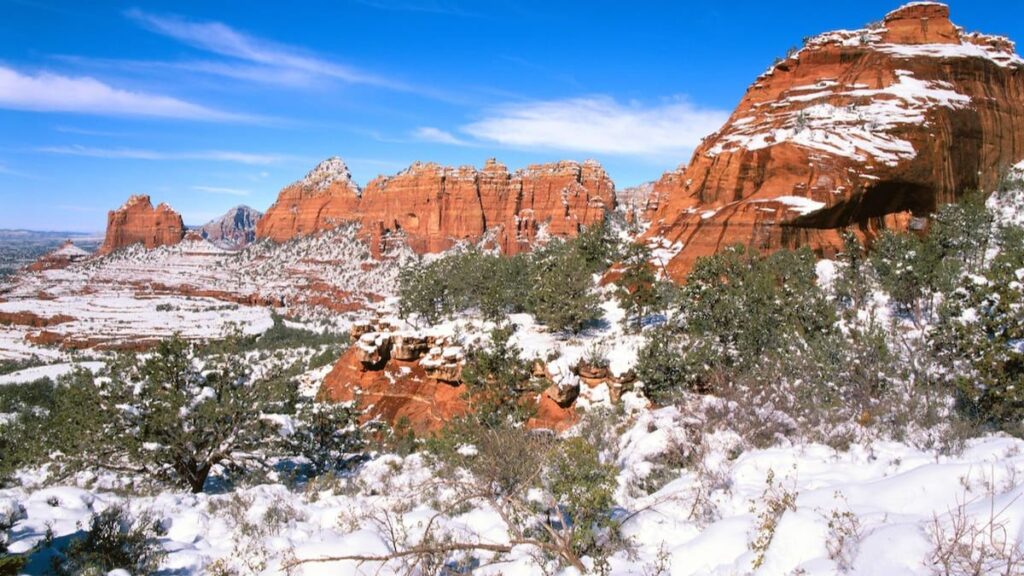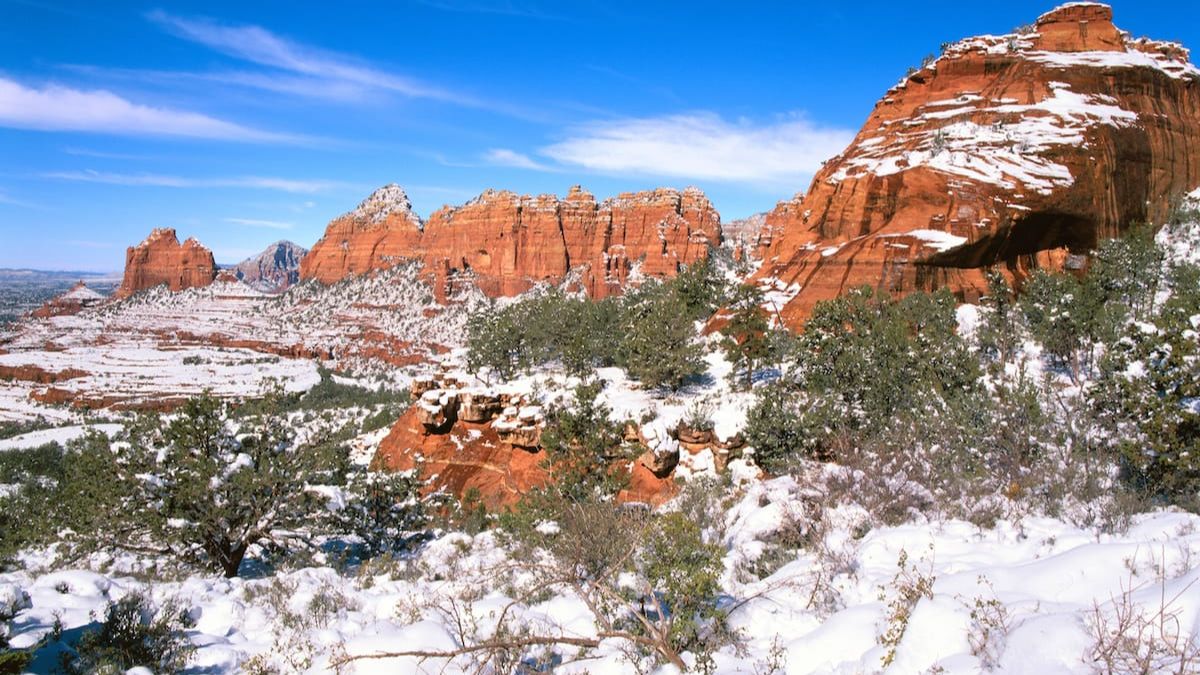Yes, it does snow in Sedona, although snowfall is relatively rare. Sedona experiences a desert climate with mild winters, but occasional snowfall occurs, particularly during winter. On average, Sedona receives around 5 inches of snow per year, spread across a few days.
Snowstorms are infrequent but can happen during the winter season. When it snows, it adds enchantment to the red rock landscapes, creating a picturesque winter scene.
Sedona, Arizona, is renowned for its stunning red rock formations, vibrant art scene, and picturesque landscapes. Nestled in the heart of the American Southwest, Sedona attracts millions of visitors each year.

However, one question that often arises among potential travelers is whether it snows in Sedona. In this article, we delve into the winter climate of Sedona, exploring its snowfall patterns and the overall experience of visiting this desert paradise during the colder months.
Location Overview
Sedona is a captivating city located in the state of Arizona, USA. Situated in the central part of the state, Sedona is known for its breathtaking natural beauty, vibrant arts community, and spiritual atmosphere.
One of the most iconic features of Sedona is its magnificent red rock formations. These towering sandstone formations, shaped over millions of years by erosion, create a dramatic and awe-inspiring backdrop for the city. Some well-known rock formations include Cathedral Rock, Bell Rock, and Snoopy Rock.
Sedona has gained a reputation as a spiritual and healing destination. The city is believed to possess a unique energy and is known for its vortex sites, which are said to enhance spiritual experiences and promote healing.
The surrounding area offers breathtaking scenic drives, allowing visitors to experience the beauty of Sedona and its surroundings. The Red Rock Scenic Byway, also known as State Route 179, is particularly popular and provides stunning views of the red rock formations.
Sedona is a captivating destination that seamlessly blends natural beauty, spiritual energy, artistic expression, and outdoor adventure. Whether you’re seeking a serene retreat, an outdoor adventure, or an immersion into art and culture, Sedona offers a truly unique experience that will leave a lasting impression.
Geography and Climate of Sedona
Sedona is nestled in the high desert of northern Arizona, surrounded by stunning red rock formations, pine forests, and the flowing waters of Oak Creek. The city is elevated at approximately 4,500 feet above sea level, offering cooler temperatures compared to the surrounding desert areas.
Sedona boasts a unique desert climate characterized by mild winters and hot summers. It falls within the USDA Hardiness Zone 8b, which signifies its suitability for growing a variety of plant species.
However, being at a high elevation above sea level, Sedona experiences slightly cooler temperatures than the surrounding desert areas.
Historical Snowfall Record
Sedona, being located in a desert region, generally experiences mild winters with limited snowfall. On average, Sedona receives around 5 inches of snow per year. However, the actual snowfall can vary significantly from one year to another.
Over the past few decades, Sedona has seen occasional significant snowfall events. For example, in January 1997, Sedona received an unusually heavy snowfall, with some reports indicating up to 2 feet of snow in certain areas.
Winter Season & Snowfall Pattern
Winter in Sedona typically spans from December to February, with January being the coldest month. The average highs range from 50 to 60 Fahrenheit, while the lows can dip to 30 to 40 Fahrenheit.
While Sedona is known for its warm and sunny weather, snowfall does occasionally occur, adding a touch of enchantment to the red rock landscapes. However, it’s important to understand that snow in Sedona is a relatively rare phenomenon.
Factors Influencing Snowfall
Various factors, including elevation, weather patterns, and proximity to the surrounding mountains, influence snowfall occurrence and intensity in Sedona.
Sedona’s higher elevations, such as Airport Mesa and Uptown, tend to experience slightly more snowfall compared to the lower-lying areas. Additionally, when storms move through the area from the northwest, they can bring precipitation in the form of snow.
Locations to Enjoy Snow
When snow graces Sedona, it opens up a range of activities that locals and visitors can enjoy. Winter hikes become more refreshing as the cool air and snowy landscapes provide a refreshing backdrop.
While snowfall in Sedona is relatively rare, here are some areas and activities that can enhance your snowy experience:
- Oak Creek Canyon
This picturesque canyon, located just north of Sedona, offers beautiful scenery and opportunities to enjoy the snow. You can take a drive along the scenic Oak Creek Canyon Road and stop at various pullouts to admire the snow-capped landscapes.
There are also picnic areas and hiking trails where you can venture out and immerse yourself in the wintry surroundings.
- Airport Mesa
Head to Airport Mesa, one of the popular vortex sites in Sedona, for stunning panoramic views of the snow-covered red rock formations. The higher elevation of Airport Mesa often receives slightly more snow than the lower-lying areas, making it a great spot to capture breathtaking winter photographs.
- West Fork Trail
The West Fork Trail is a popular hiking trail in Oak Creek Canyon known for its beauty and tranquility. The trail takes on a new charm when snow blankets the canyon. Walking along the trail, surrounded by snow-covered trees of Oak Creek, creates a serene and magical experience.
- Uptown Sedona
The main commercial area of Sedona, known as Uptown, can also be an enchanting place to enjoy the snow. The streets and buildings adorned with a dusting of snow create a cozy and festive atmosphere.
- Slide Rock State Park
While not specifically a snow-focused location, Slide Rock State Park offers a unique winter experience when snowfall occurs. The park features a natural waterslide and swimming area, but during the winter, the snow-covered rocks and frozen pools create a different kind of beauty.
Remember to check local weather forecasts and road conditions before venturing out to these locations during or after a snowfall. Some roads and trails may be inaccessible or require extra caution.
Conclusion
While snowfall in Sedona is relatively rare, the desert city surprises lucky visitors with its occasional winter wonderland. The magic of witnessing snow-dusted red rock formations against the desert backdrop is an experience to cherish.
So, if you are planning a trip to Sedona during the winter months, keep an eye on the weather forecast, pack your warmest attire, and embrace the possibility of encountering the captivating beauty of a snowy Sedona.
